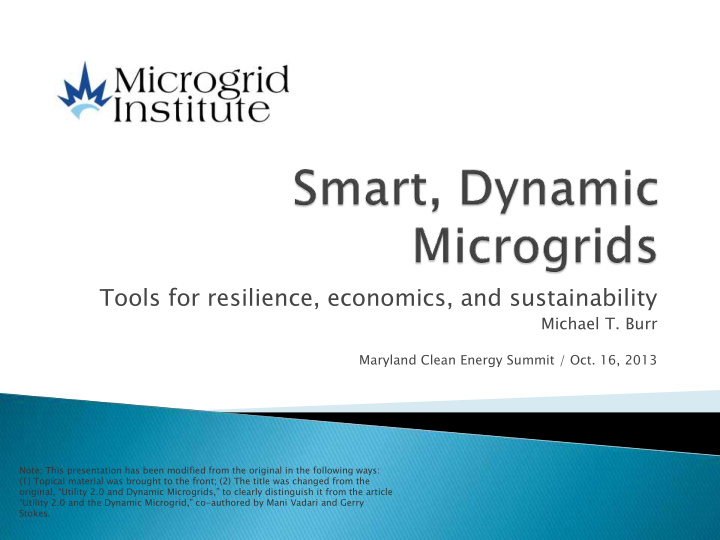



Tools for resilience, economics, and sustainability Michael T. Burr Maryland Clean Energy Summit / Oct. 16, 2013 Note: This presentation has been modified from the original in the following ways: (1) Topical material was brought to the front; (2) The title was changed from the original, “Utility 2.0 and Dynamic Microgrids,” to clearly distinguish it from the article “Utility 2.0 and the Dynamic Microgrid,” co -authored by Mani Vadari and Gerry Stokes.
As a dynamic component of an engineered smart grid, a microgrid becomes a major asset for the utility of the future. Michael T. Burr Oct. 16, 2013
defini niti tion* on*: Micr crogr ogrid id A local energy system capable of balancing captive supply and demand resources to maintain stable service within a defined boundary. Microgrids are defin ined ed by their function tion, not their size. Microgrids combine various distributed energy resources (DER) to form a whole system that's greater than its parts. Most microgrids can be further described by one of three categories: Isolat lated d microgr ogrids ids, , including those on • islan ands and at remote inlan and sites, not connected to a local utility. Islan anda dable ble microgr grids ids that are fully • interconnected and capable of both consuming and supplying grid power, but can also maintain some level of service during a utility outage. Non-synchron ronou ous microg ogrids rids are connected • to utility power supplies, but they aren't inter connected or synchronized to the grid. Such non-synchronized microgrids are *Source: Microgrid Institute capable of consuming power from the grid, but they aren't capable of supplying it. www.microgridinstitute.org Michael T. Burr Oct. 16, 2013
Micr crogr ogrid id Drive ivers rs in Industri dustrialize alized d Mar arket kets ▶ “Supply Surety” † ▶ Social Policy especially at mission-critical Environmental liability, jobs/economic development in various jurisdictions – and outage-sensitive facilities states, cities, and economic development zones Military and government • Renewable mandates • installations Environmental constraints • Institutional campuses • Sustainable/domestic fuel preferences • (universities, hospitals, Local self-reliance • prisons) C&I sites (data centers, • ▶ Transm smiss ssion congest stion corporate campuses, factories, processing plants) Siting challenges, load pockets, Communities that repeatedly least-cost regional planning • endure extended outages (NE, Florida, etc.) ▶ Economic competiti tiven veness ess vs. high-cost utility power. Where DG is near grid parity, microgrids can optimize † Government agencies and laboratories in the U.S. use the terms “surety” and capacity and add value. “assurance” in describing energy supply priorities. Related engineering and regulatory concepts involve resilience, reliability, and power quality. Michael T. Burr Oct. 16, 2013
Dynamic Grid: A work in progress Dynamic Grid Smart Grid DA and SCADA Early distribution Technology Systems engineered standards and with smart grid automation and common information technologies bring SCADA systems models accelerated greater flexibility and brought modern smart grid resilience. information development. Automatic technology, AMI allows advanced reconfiguring switching, and demand response systems bring communications and efficiency microgrid systems onto the applications. architecture to the electric grid for the macro grid. Outage management first time. systems bring new Smart switching and “self - healing” distributed capabilities. intelligence allows dynamic microgrid islanding and DG exploitation. Michael T. Burr Oct. 16, 2013
Dynamic Microgrids “Dynamic microgrids have the potential to be a key element of the ultimate self- healing grid – the Holy Grail of the smart grid. They allow the grid [during an outage or adverse event] to divide itself into smaller self-sustaining grids, which can then be stitched back to form the regular distribution grid .” -Mani ni Vadari, Modern rn Grid Solutions ons (forthcoming article in Public Utilities Fortnightly, November 2013) Michael T. Burr Oct. 16, 2013
Dynamic Microgrid: A work in progress Dynamic Islandable Backup Power Microgrids Microgrids Systems Diesel/gas backup Microgrid As part of a planned power systems are technologies bring smart grid, rudimentary together DR, storage, microgrids bring microgrids. and DG with the greater resilience capability to operate and faster outage Their primary in isolation. restoration. function is to provide supply surety for Demand-side Advanced microgrids host facilities. technologies reduce bring voltage overall energy costs support and Utility tariffs for and improve service dispatchable load interruptible power levels during island and generation. brought added value operation. for backup power Non-transmission systems. Utilities begin alternatives (NTA) planning for defer high-voltage microgrids. transmission costs. Utilities develop the dynamic grid. Michael T. Burr Oct. 16, 2013
DG Technology Trajectory Manufacturing scale economics vs. system scale economics Fuel el cell lls, s, micro crotu turb rbines nes, , Batt ttery ery storage orage, , V2 V2G EV EV smart t charg rgin ing Gas-fired engines, pack ckag aged ed Aeroengines, CHP CHP Dyna namic, ic, diesel gensets, integra tegrated ted, , energ rgy y and backup manage nageme ment nt Roofto oftop PV generators syst stem ems. Aggregated DR and market Dispatchable transactions demand response Michael T. Burr Oct. 16, 2013
Microgrid Regulation & Markets: More works in progress Finance Customers Regulation Outdated and Resistance to Complex discriminatory adopt new commercial standards energy arrangements. technologies. Disincentives in Perceived utility revenue Short memory technology risk. models. and low budget Regulatory for perceived Inadequate and barriers = “premium” unclear policy complicate energy services. treatment. financing Distrust of structures. upstart/non- Institutional utility energy resistance = companies. increased risk for investors. Michael T. Burr Oct. 16, 2013
For more information … “Economy of Small : How DG and Microgrids Change the Game for Utilities,” by Michael T. Burr, Public Utilities Fortnightly, May 2013 http://ow.ly/mZczd Foll llow ow our soci cial media ia feeds eds Micro crogrid rid Subred reddit http://www.reddit.com/r/microgrid DG/ DG/DR DR/DE /DER R Subred reddit http://www.reddit.com/r/DGDR/ RSS http://www.reddit.com/r/microgrid.rss Michael T. Burr Oct. 16, 2013
Ho How to r o reach ach me me Michael T. Burr Director, Microgrid Institute mtburr@microgridinstitute.org www.microgridinstitute.org Connect with me on LinkedIn
Recommend
More recommend